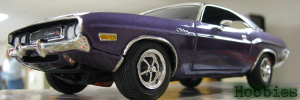















An introduction to collecting car brochures - Part 3 - What to look for when buying. |
|---|

|
Annette Brown
Amazines.com
January 24, 2006
If you have read the previous articles in this series (they can be read on this website or http://forums.retroretro.com/ ), you should now have a clear idea of what brochures you are trying to obtain for your collection.
Now for the fun bit! Starting, maintaining and increasing your collection.
As you are collecting second-hand items, the condition of an item you are after can vary dramatically. Also, it does not help that sellers regularly either omit or misdescribe items.
Therefore, it is paramount that you ask the right questions and look for what the seller hasn’t said as much as what he has in his advert description.
Having been disappointed on more than a few occasions when a “pristine” item has arrived through my letterbox, I have a checklist that I consult before committing to buying. The list is as follows:
1)What is the size of the item in centimetres? Pictures can be deceptive and what looks like a 21cm x 29cm item, may be much smaller in size.
2)How many pages long is it? Beware that on smaller brochures, there can be confusion between seller and buyer with what represents a page. My firm only uses the term “pages” for items that are 6 pages long or more. Otherwise, we use the term number of “sides”. As a reputable seller, this avoids any confusion and disappointment.
3)What is the reference number of the brochure? Most manufacturers have a code system for their brochures that you will become familiar with very quickly. By keeping a note of the references, you will avoid duplicates in your collection.
4)What is the condition of the brochure? Amazingly, very few sellers have a condition scale attached to the advert (we do). One person’s “pristine” may be fit only for the bin in other collectors eyes! I therefore ignore vague words like the above and ask direct questions – Has it any creases or tears and if so how many and how bad? Any fading? Any foxing (A term used to describe stains, specks, spots and blotches in paper)? Any water or damp damage?
5)How will the item be delivered to you? On auction sites especially, it is natural to go for the cheapest posting method. However, if the item is being sent for the cost of the stamp, can you really expect anything more than for it to be delivered in a flimsy envelope? Probably not. The only way that a collectable paper item should be sent is in a card-backed envelope preferably marked “do not bend” with the item wrapped in plastic to prevent water damage and a return address inside, just in case the postal system loses it. I also insist on a proof of posting, again just in case the item goes missing. For any item over a preset limit, in my case £30/$60, I offer to pay extra for recorded delivery. Better safe than sorry.
If you get a satisfactory answer to the questions above, you will be as certain as you can be that you will get the item and that it will be of a standard reflecting the price you have paid. The list sounds a bit daunting, but essentially it boils down to ensuring you know what you are getting and making sure it arrives in the same condition with which it left the seller.
Many is the time that I have received a sodden envelope that contains a perfectly preserved item because I have insisted on it being wrapped in plastic. If the seller says, he does not normally do this, offer to pay extra for the service or if practical, collect the item. If your seller cannot or will not take this care, may I suggest that you walk away and wait for another to turn up.
Please remember that for older brochures especially, a bit of fading and foxing and the odd crease or small tear is perfectly acceptable. In fact, I prefer an item with a patina to an “as new” item as it seems to have more character.
Finally, unless it is extremely rare, I would avoid buying any incomplete, falling apart or badly damaged brochures. On the whole, they have little or no value and it is best to wait for a better one to be offered for sale.
Next week, I will be discussing the correct way to store your collection.
